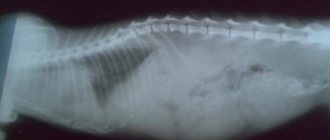Types of tumors on the paws of dogs - malignant and benign
Veterinarians distinguish many reasons for the development of tumors on the extremities, but still the main types of tumors on the paws of cats are malignant and benign varieties.
The most dangerous are malignant neoplasms (oncology):
- Such tumors are very hard, dense to the touch, and often have a lumpy, uneven surface.
- As a rule, cancerous “bumps” are hairless, with only sparse hairs growing on their surface.
- A malignant tumor is very difficult to distinguish from healthy tissues. The neoplasm on the cat's paw completely fuses with them; it is impossible to draw clear boundaries.
- Ulcers, wounds, and other types of sores often form on the surface. Malignant tumors very often bleed, which is practically not observed in benign tumors.
- On palpation, clearly defined pain appears, or the pet experiences an unpleasant sensation. At this point, palpation must be stopped, since any mechanical effect on a malignant tumor is fraught with the formation of metastases.
Benign tumors are characterized by the following:
- They are soft to the touch and have a doughy consistency.
- Hair usually grows on their surface.
- Bleeding is extremely unusual for benign neoplasms.
- It is not typical for them to form sores, wounds, cracks, etc.
- No pain is detected on palpation.
- Many types of benign neoplasms have a kind of “leg”, which makes them resemble large warts.
Why is arthritis of the ankle and foot dangerous?
The disease is dangerous because it often goes unnoticed and leads to a complete loss of joint function, that is, the person becomes disabled. Acute purulent complications of ankle arthritis are also dangerous.
Arthritis of the foot and ankle begins gradually, unnoticeably
Stages
There are several stages of disease development. The inflammatory process develops gradually, turning into a degenerative-dystrophic one:
- Early – inflammation
. The synovial membrane swells, and inflammatory exudate appears in the joint cavity. Pain is moderate, swelling and redness are absent or only slightly expressed. - Explicit – inflammatory-proliferative process
. The synovial membrane increases in volume, erosions appear on the cartilage, and soft granulations of connective tissue grow in the articular cavity (the process of proliferation - growth). The inflammatory process intensifies. Externally, this is manifested by increased swelling, redness and pain. - Progressive - mild ankylosis
. The cartilage is destroyed, soft granulations turn into dense connective tissue that grows in the joint cavity. Bone growths appear. The joint gradually loses its mobility. Pain, swelling and redness continue to bother you constantly or during exacerbations. - Advanced - complete immobility (bone ankylosis).
There is no cartilage tissue, bone growths connect the articular surfaces of the ankle, which eliminates movement in the ankle and foot (ankylosis of the ankle). The pain is constant, arthritis of the foot develops with limitation of its function.
Possible complications
If ankle arthritis is left untreated or treated independently with home remedies, the following complications may develop:
- purulent processes - abscesses, phlegmon, sepsis;
- subluxations and dislocations of the ankle;
- development of foot arthritis;
- immobility of the ankle and inability to move without assistive devices.
Other reasons for the development of tumors on the paws
Of course, there are other reasons for the development of tumors on the paws, which have nothing in common with neoplasms of a benign or malignant nature.
Injury
One of the most common causes of swelling on the paws is a bruise. In this case, strong mechanical impact leads to the destruction of some cells. Their contents “spill out” into the intercellular space, as a result of which the tissues swell and traumatic edema develops. Its origin can be guessed by external signs:
- Abrasions, scratches and other damage to the skin at the site of injury are visible.
- In the first hours, the temperature of the injured area does not differ from the temperature of the surrounding tissues or is slightly increased. Subsequently, due to the contamination of the injury site with pathogenic microflora, the swollen area can become very hot. If the process proceeds aseptically, the swelling becomes cold.
- In the first hours after the injury, palpation reveals severe pain, which subsequently (with inflammation) can either intensify or disappear.
As a rule, bruises resolve spontaneously, and the need for veterinary intervention occurs infrequently.
Fracture
An “intensified” version of traumatic edema is edema that develops as a result of a fracture. A fracture causes the formation of a tumor according to the same principle, but its symptoms are more pronounced:
- Abrasions, deep scratches and “filled” bruises are also visible.
- If the fracture is open, fragments of broken bone can be seen in the thickness of the wound channel. Of course, in this case, heavy bleeding will definitely attract attention.
- Traumatic edema during fractures develops quickly, it is very large, and the tissues acquire a doughy consistency. On palpation, very strong pain is felt.
General information about the disease
Arthritis of the ankle joint is an inflammatory process that has different origins, symptoms and course. The disease can be independent (primary) or develop against the background of some existing process (secondary). Arthritis is divided into acute and chronic. ICD-10 code M00 – M99.
The ankle joint is a movable joint formed by three bone structures: the heads of the tibia and fibula of the leg and the talus of the foot. To the right and left of the talus are bony elevations - the ankles. The peculiarity of the joint is its resistance to external influences, in this it is much superior to the knee joint. It has a good blood supply and innervation and is protected by ligaments that firmly hold it in the desired position.
Arthritis of the ankle develops at any age. In children it is predominantly juvenile idiopathic arthritis (JIA), in women it is rheumatoid lesions, in men it is reactive arthritis.
Tumors by location
It is possible to guess the origin of the tumor based on its location, but this diagnostic method does not always work.
But there are still pathologies that most often appear on the front/hind legs.
On the front paw
Most often, tumors develop on the front paw for the following reasons (taking into account the possibility of the appearance of tumors):
- Injuries, including fractures.
- It is in the soft tissues of the front paws that splinters are most often found. They can cause both traumatic swelling and abscesses. The latter develop due to pathogenic microflora entering the wound canal. In the latter case, the tissues swell, become hot and thicken. As the abscess matures, it softens.
- Possible formation of hematomas. Due to strong impacts or other traumatic influences, blood vessels may be damaged. The blood coming out of them accumulates in the subcutaneous tissue and under the skin. In the first days the swelling is soft, after a few days it thickens and hardens.
On the hind leg
Tumors on the hind leg develop due to:
- The hind limbs very often become swollen and swollen in diseases of the heart and kidneys. The swelling is cold and dense.
- In addition, swelling of allergic origin often develops in the hind legs.
- Sometimes this is how myositis (muscle inflammation) manifests itself. These cases are characterized by severe pain.
All described pathologies can develop with equal probability on all paws.
Between the fingers
A tumor between the fingers is a common consequence of fungal pathologies. Malassezia is especially famous for this. This pathology, caused by yeast, is not typical for cats, but in practice it still occurs. Characterized by the following symptoms:
- Strange, lumpy growths appear in the spaces between the fingers.
- They are soft and “cheesy” to the touch.
- A strange, moldy, musty smell emanates from the paws of a sick animal.
What to do in an emergency?
In case of injury or after surgery, the owner should know how to provide first aid to the pet:
- If a cat's hind legs are swollen after anesthesia, and the sore spot is hot when touched, it may be thrombophlebitis. You should lubricate the limb with Troxevasin liniment and take the pet to the veterinary clinic.
- If you have tightened your paw with a clamp, you need to loosen it a little so that blood circulation is restored and the swelling goes away.
- In case of a bruise, you should apply a cold compress, alternating for 15 minutes, which will help relieve pain and prevent the development of swelling.
The sore limb of the fluffy needs to be secured with a bandage.
For fractures and dislocations, the algorithm for assistance is as follows:
- Provide rest to the limbs and limit the cat’s mobility.
- Apply a cold compress.
- Secure the paw with planks, making a soft spacer between the skin and the clamp.
- Apply a bandage, not too tight.
Drug treatment of tumors
Veterinarians practice drug treatment of tumors in the following cases:
- Abscesses. They are opened (i.e., surgery is still necessary), the cavity is washed with 3% hydrogen peroxide, and filled with streptocide or other antiseptic powder. Sometimes drainage installation is required. In most cases, antibiotics are prescribed.
- Some types of arthritis, arthrosis. Chondroprotectors are prescribed (Hip and Joint Extra Nutri-Vet, Dolfos ArthroFos, Chondroitin complex and others), as well as anti-inflammatory corticosteroids.
- Fungal pathologies. Antifungal drugs are used (Itraconazole, antibiotics from the griseofulvin group, Yam ointment and others).
General clinical recommendations
Arthritis of the foot and ankle is a progressive disease. To prevent its relapse, the patient should follow the following recommendations:
- lead a healthy lifestyle, move more;
- regularly perform physical therapy exercises, go swimming;
- avoid heavy physical activity, hypothermia and stress;
- promptly treat all acute and chronic diseases;
- give up bad habits - smoking and alcohol abuse;
- conduct courses of preventive treatment as prescribed by a doctor.
Prevention
To avoid the development of the disease, genetically predisposed persons, as well as persons whose work involves increased stress on the ankles, should avoid provoking factors that can become a trigger for the development of the disease. These are hypothermia, viral infections, prolonged stress and high physical activity.
Follow a diet: give up fried, fatty, spicy foods, sweets and baked goods, eat regularly. The diet should include: low-fat animal products, vegetables and fruits.
If symptoms of foot arthritis appear, you should immediately consult a doctor.
Surgical removal of the tumor
In more severe cases, surgical removal of the tumor is used:
- Serious arthritis and arthrosis. Dead tissue is excised and, in ideal cases, joint replacement implants are installed.
- Malignant and benign tumors. They are cut out, trying (especially in the case of cancer) to capture as much adjacent tissue as possible. In addition, chemotherapy drugs are prescribed for cancer.
- Hematomas. They are opened, the cavity is washed with hydrogen peroxide and filled with antiseptic powder.
Possible postoperative complications
Let us note that many possible postoperative complications are possible only in case of serious violations of the rules of asepsis and antisepsis, as well as in case of non-compliance with the rules of care for the operated animal. We are talking about the development of postoperative inflammation, which is fraught with sepsis and even the death of the pet.
When cancerous tumors are removed, the consequences are much more serious - metastasis of the neoplasm with the subsequent appearance of new tumors in other organs and tissues of the cat's body. To avoid this, chemotherapy is given.
Diagnostics
To establish the correct diagnosis, taking into account the origin of the disease, the doctor first asks the patient about the onset and duration of the disease, its symptoms, and diseases of close relatives. Then a thorough examination of the patient is carried out to identify painful areas, the state of the ankle and foot function. The diagnosis is confirmed by laboratory and instrumental studies:
- Laboratory tests
- blood, urine, joint fluid taken by joint puncture (puncture) or during arthroscopy. The following are revealed: the severity of inflammation, the presence of infection, metabolic and hormonal disorders, autoimmune processes. - Instrumental studies
:- Ultrasound
- an increase in the volume of the synovial membrane, the presence of a large volume of exudate; - X-ray of the ankle and foot
– bone changes: narrowing of the joint space, bone growths, deformities; - MRI and CT
are the most informative studies; they reveal any changes; - arthroscopy
- examination of the internal articular surface using optical equipment (arthroscope).











